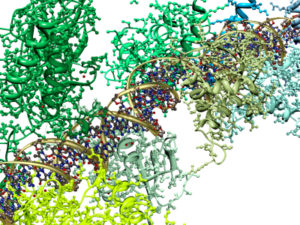 The best supercomputers cannot calculate each of three superimposed processes – DNA regulation, protein folding, and alternative RNA splicing. If these are not complex enough, intelligent RNA small and large show even more intricate functioning.
The best supercomputers cannot calculate each of three superimposed processes – DNA regulation, protein folding, and alternative RNA splicing. If these are not complex enough, intelligent RNA small and large show even more intricate functioning.
The rapid evolution of non-coding RNA particles separates human beings from all other creatures.
If DNA strands in jumping genes and viruses show cognitive processes, how much greater are the cognitive functions of intelligent RNA particles small and large?
Previous posts have discussed multiple layers of complexity in the production of protein shapes in neurons, each stage far beyond the calculation abilities of supercomputers. In fact, to calculate just the possible protein folds of one medium sized protein would take longer than the age of the universe (see post of Protein Folding). Another post noted attempts to synthesize the vast network of related regulation for protective layers of chromatin, the 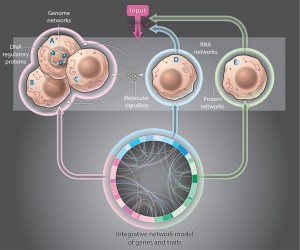 uncovering and epigenetic marking of naked DNA, the alternative splicing of transcripts of messenger RNA, and the editing and remodeling of transcripts before proteins are made.
uncovering and epigenetic marking of naked DNA, the alternative splicing of transcripts of messenger RNA, and the editing and remodeling of transcripts before proteins are made.
ENCODE, Encyclopedia of DNA elements (see ENCODE posts 1, 2, 3), showed that approximately fifty percent of the DNA are jumping genes, and another fifty percent make non-coding RNA particles (ncRNA). Many of these RNA particles demonstrate very elaborate functions, not just regulation of DNA, but very specific targeting of many different cellular functions. In fact small RNA particles can regulate intracellular function in organs, and the complex timing of fetal development.
RNA Evolving
Everyone learned in school about transfer RNA, messenger RNA and ribosomes. DNA codes the messenger RNA, which travels to the ribosome, where proteins are manufactured with the 20 different amino acids carried by 20 specific transfer RNAs.
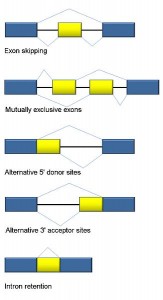 No one was prepared for the vast complexity of messenger RNA alternative editing to create the large number of needed proteins. A previous post shows that one “so called gene” or piece of DNA can be involved in the coding of 500 different proteins in humans and 30,000 in other creatures. In fact, one letter of code, or nucleotide, can be involved in multiple overlapping RNAs with vastly different functions.
No one was prepared for the vast complexity of messenger RNA alternative editing to create the large number of needed proteins. A previous post shows that one “so called gene” or piece of DNA can be involved in the coding of 500 different proteins in humans and 30,000 in other creatures. In fact, one letter of code, or nucleotide, can be involved in multiple overlapping RNAs with vastly different functions.
Since the new classes of RNA particles are primarily discovered by sorting RNA particles by size (fractionation) they are often described as long, short, micro, etc. Another source of the names is binding to specific proteins already known to be factors in control of DNA. Tens of thousands of different types of RNA are just beginning to be defined.
It should be remembered that only ten years ago micro RNA’s function was first described.
Non coding RNA (ncRNA) the Complexity of Human Beings
The many varied ncRNA mechanisms involve intra and inter cellular mechanisms, structural shape 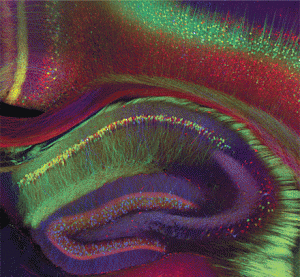 changing, and modification after transcription, making them perhaps the most versatile and varied functional particles. These RNA particles can also modify and change each other making it much more complex.
changing, and modification after transcription, making them perhaps the most versatile and varied functional particles. These RNA particles can also modify and change each other making it much more complex.
The great complexity in RNA has occurred in the evolution of primates and especially in human beings. The most complex RNA editing of all is in the human brain.
Intelligent RNA Small and Large
Of the 98 percent of the genome DNA that are not genes, that is, DO NOT code for proteins, half are jumping genes and the other half code for RNAs that are either large or small.
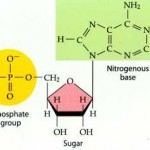
These RNAs can interact with DNA, RNA and proteins at all levels. Like tubules they can become structural components of machinery with multiple functions. They are involved in regulation at all of the levels that were established in ENCODE – nuclear organization, transcription and post transcription activity, and epigenetics.

The size of an RNA particle is measured by the number of nucleotides, (nucleotide is the basic letter in the DNA or RNA code). See picture (above) of one nucleotide and those joined together as RNA (right side).
Small Non Coding RNA
The importance of small RNA has been rapidly expanding since the recognition of microRNA interference about ten years ago. Micro RNA is properly referred to as “miRNA.” These RNAs, approximately 20 nucleotide long, are cut from larger strands, and “interfere” with making of a protein. (This is called RNA interference or RNAi).
miRNA are cut by an important enzyme called DICER, and then planted onto large multi protein machines called RISC, short for RNA induced silencing complex. RISC is able to take small RNAs and find the silencing target. The RISC machine uses the code of the small RNA to cut the exact spot for silencing, stopping the manufacture of a protein.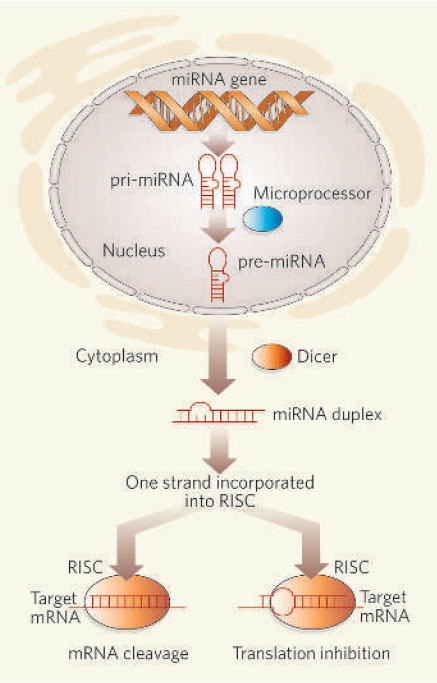
One small miRNA can be involved in regulating hundreds of different messenger RNAs; likewise, many different microRNA particles can regulate the same messenger RNA. To confuse us further, these particles can regulate each other as well.
There are many different new classes of small RNA, such as small interfering RNA (siRNA), small nuclear RNA (snRNA), small nucleolar RNA (snoRNA).
They have varied and overlapping functions including gene expression, blocking jumping genes and attacking viruses.
As an example of the complexity and usefulness of small RNA, this post will focus on one particular class – piRNA, pronounced “pie RNA”. piRNA have 26 to 30 nucleotides, slightly longer than the 20 nucleotides of miRNA.
piRNA
The name piRNA comes from a class of proteins called PIWI, which are in most plants and animals. PIWI proteins regulate stem cells and the very important germ line (the line of cells that produce offspring). PIWI proteins are involved in cutting strands of RNA and regulating proteins. piRNA form complexes with PIWI proteins.
piRNA exist in clusters throughout the genome. Clusters can contain from ten to thousands of different piRNAs in a long strand of the chromosome. There are at least ten different proteins that are involved in cutting up the cluster into piRNA fragments.
Uniquely, piRNA provide an immune system for the genome.
piRNA’s Regulate and Protect the Genome
A great amount of the human genome is made of jumping genes. A previous post discussed that epigenetic regulation developed in human beings to counter potential negative effects of this large number of jumping genes. If not checked, the jumping genes can create cancer. Protection of radical changes in the germ line DNA is especially important.
piRNA are a specialized group of RNA molecules, which rescue cells from the negative effects of the jumping genes. These small piRNA combine with PIWI proteins to form an immune system for the genes.
 Somehow piRNA particles, like immune cells, can identify “self” and “not self” (see post on immune and nervous system). Like immune cells piRNA respond to threats, and remarkably, like the immune system, they adapt to new types of threats, and maintain a memory of all previous reactions.
Somehow piRNA particles, like immune cells, can identify “self” and “not self” (see post on immune and nervous system). Like immune cells piRNA respond to threats, and remarkably, like the immune system, they adapt to new types of threats, and maintain a memory of all previous reactions.
Like alternative splicing, the piRNA immune system has evolved very rapidly, much more rapidly than the genome. It now appears that there are millions of different piRNA that only occur in animals – not in plants, fungi, or protists. By far, the most complex system of piRNA is in human beings.
The current research into piRNA has focused on how they protect the germ cell, but is now clear that they do much more than that. In mice hundreds of thousands of different piRNA have developed for regulation, which appear to be related to the jumping genes.
How Do PiRNA Function Like the Immune System?
The piRNA can detect danger from jumping genes. They do this by having fragments of the jumping genes mixed together in the cluster with piRNA fragments. This is the memory of the system protecting the cell from the jumping genes. It’s the way animals write down and keep track which jumping genes have invaded their genome.
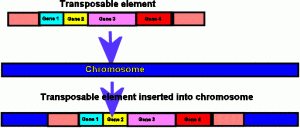 piRNA matches the sequence with the jumping gene. This is very much like antibodies in the immune system, where specific proteins are made that match surface proteins of virus and bacteria.
piRNA matches the sequence with the jumping gene. This is very much like antibodies in the immune system, where specific proteins are made that match surface proteins of virus and bacteria.
Often jumping genes first copy their code from DNA to RNA and then back to DNA in the new location. If this code is not used to make a protein, then piRNA treats it as invading DNA. If the new code makes a new protein, then the piRNA will not go after it. The mechanism of this is unknown.
New jumping genes land in many different places and eventually in a piRNA cluster. When this occurs, the piRNA system has captured this jumping gene for control and it becomes part of the memory of the system. The cluster is really a trap that creates immunity.
In the same way that the immune system eventually cleans up infections by finding and destroying the virus through immune memory sequences related to the virus, the animal can be cured of the jumping gene effects by the piRNA.
An example is a fly that was infected by a jumping gene, causing infertility in the line. The jumping genes all started working together to control the genome. But, then the fly started creating more piRNA, which silenced the various jumping genes. More and more jumping genes fell into piRNA clusters and strengthened the response to the jumping gene.
When the piRNAs are ready to attack the jumping genes, they can bring proteins to cut up the jumping genes. They also bring siRNAs (small interfering RNA) along to interfere and stop the jumping gene. There are more siRNA’s available to help the piRNA fight the effect of the jumping genes.
Recruiting the Enemy
A productive strategy in a war is to recruit enemy soldiers to join forces. This exactly what piRNA and PIWI proteins do in a dramatic process called Ping Pong.
In this unusual mechanism, piRNA with the PIWI proteins cut up a jumping gene. The pieces of the jumping gene are then modified and become piRNA’s themselves. This process makes an attack on a large system of jumping genes even more effective. This loop takes code from the jumping genes and turns them into piRNA warriors to attack other locations of jumping genes.
Another tactic used by piRNA is to stimulate epigenetic methyl groups on the jumping genes. This methylation is the well-known identification system used in epigenetics of the DNA and histones, which is used to silence sections of the genome. Methylation can stop future copying and jumping of the gene. These piRNA inspired techniques permanently disable jumping genes. This suppression of jumping genes can last generations.
Long Non-Coding RNA – lncRNA
Long non-coding RNA, lncRNA, have many different functions both functional and structural. Most of the genome are transcribed during development producing a very large amount of large RNA’s – 10,000 to 200,000 different types. Significantly, one strand of DNA can be part of multiple long RNA’s – on average 10 long RNA coding areas overlap each gene.
lncRNA are longer than 200 nucleotides, but can be much greater than that. They are very complex and can be coded forward or backward, called sense or antisense; overlapping; or bidirectional.
Surprisingly, despite their length and complexity, they undergo a lot of editing and processing.
The editing can include specific capping, a unique alternative splicing, polyadenylation – that is, putting a tail on the long RNA – and editing. They can form machinery with multiple proteins. Long RNA can have local effects on genes, or can have wide ranging effects on regions, and even an entire chromosome.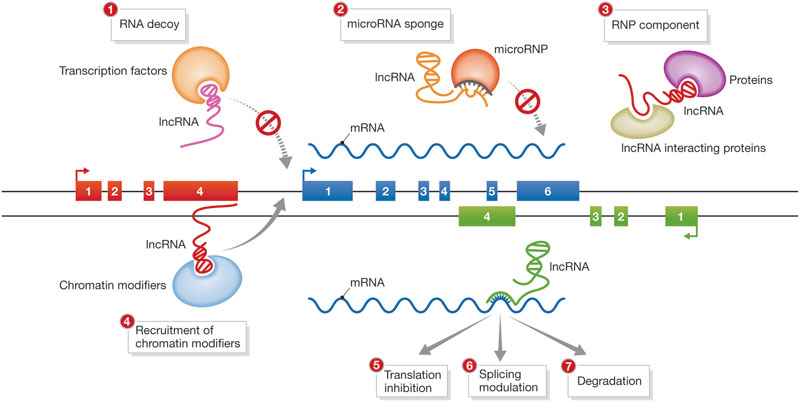
They can also be broken up to form small RNA’s including microRNA.
Long RNA have so many different functions that classifications are being developed which include: signals for specific stimuli, temporal, spatial and during fetal development; inhibition of many proteins and RNA molecules; guides for factors related to epigenetics and transcription; and scaffolds for large machinery
First Major Long RNA Breakthrough
The first major breakthrough in understanding lncRNA was in the X chromosome. A region of the X chromosome makes many copies of the Xic lncRNA, approximately 20,000 nucleotides long. Multiple pieces of this huge RNA coats the entire X chromosome – silencing the entire chromosome (see picture). This silencing involves many very complex processes, involving many other long RNAs that interact positively and negatively in the process.
For many reasons, it appears that RNA’s are much better at blocking a chromosome than proteins. The RNA can more specifically bind to and influence a larger section of DNA, better than proteins that will only bind to one small section. The fact that RNAs degrade rapidly allows targeting to be very specific, unlike proteins that may linger and cause other problems. Because it is degraded rapidly it only operates on the nearby chromosome (cis process means on the same DNA strand nearby) not on far away DNA (trans process means it operates far away).
The large RNA has unique features not shared by small RNA, transcription factors or proteins. Small RNA is too small to effect or silence a large DNA strand, and proteins are not specific enough. Transcription factors are very effective for epigenetics since they can operate in many areas and in large networks. The large RNA had a very long very specific code that occurs only once and will operate well on a single location.
Fetus Development and lncRNA
Development involves specific timing of cells and specific spatial structures that are coordinated in very complex ways. Small transcription factors can have global effects, and long RNA can have a very specific effects in one targeted region.
Thus long RNA’s can effect major local changes and be signaled and timed by the small global factors. In development, thousands of these small global factors and local long RNA’s would work in parallel to achieve the unbelievable coordination of the development of a fetus.
Conclusion – Very Complex RNA Functions
The most radical conclusion of ENCODE was that at least 20 percent of the genome is actively making non coding regulatory RNA. This 20% is a region 20 times larger than the 1.5% of the DNA called the “so called gene”. But, it is possible that the non-coding regulatory RNA is actually 50% with the other 50% being jumping genes. This would be mean an unfathomable number of specific large and small RNAs.
Shockingly, the more research that is done, the more the small and large RNAs are found to have functions. And the functions are very complex. This post has described just two of hundreds of thousands of RNAs.
From these two cases, piRNA small RNA and Xic long RNA, it can be seen that their function is highly complex.
 RNAs have recently been shown to be very involved in brain evolution, brain development, synaptic plasticity and many brain diseases. The RNA effect in the brain will be discussed in the next post.
RNAs have recently been shown to be very involved in brain evolution, brain development, synaptic plasticity and many brain diseases. The RNA effect in the brain will be discussed in the next post.
Just as pieces of DNA in jumping genes show the same editing cognitive ability of microbes, these RNA also show extremely complex processes. It has to be asked whether RNA also share cognitive processes, possibly even greater than DNA.